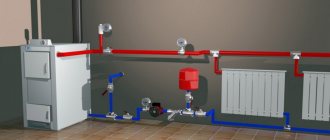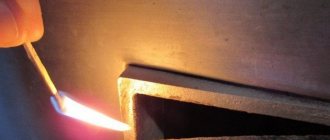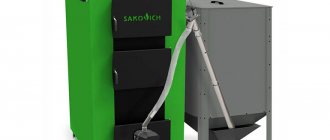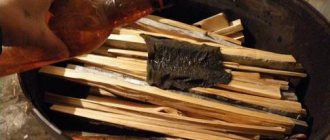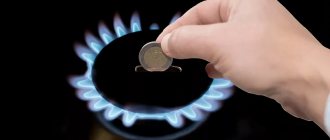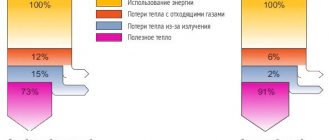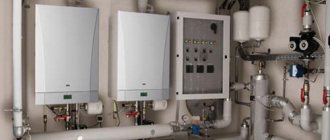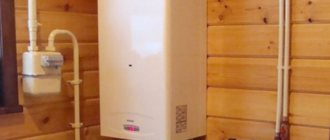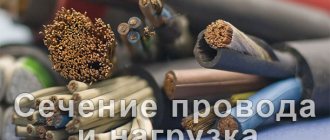Unfortunately, for many owners, using solid fuel to heat their homes still remains the only option. However, why “unfortunately”? According to some owners, no other type of heating can compare with, say, wood heating in its ability to create a truly comfortable atmosphere in the premises. And even if it is possible to switch to another energy source, they are in no hurry to do so.
Solid fuel for a stove or boiler
So, solid fuel equipment has been and will continue to be in widespread demand. This means that its owners, real and even more so potential, should understand the diversity of this fuel. Know the advantages and disadvantages of each type available for use in your conditions. Be able to at least roughly predict consumption.
This publication is devoted to these issues. And let’s start our consideration, of course, with the most popular solid fuel in our area - ordinary firewood.
Classification of fuel types
Based on physical properties and phase state, fuel is divided into the following types:
- Gaseous;
- Solid;
- Liquid;
- Electricity;
- Energy from alternative sources.
In addition to physical and chemical indicators, energy carriers differ in the algorithm for converting them into thermal energy. In accordance with it, heat-generating equipment is selected - boilers, stoves, individual heating devices.
Depending on the type of fuel, the installation procedure for heating equipment, its cost, the configuration of the heating system, and the amount of costs during the heating season differ.
To begin with, we will highlight the main criteria by which we will evaluate the selected fuel.
- The price for 1 kW of heat is the most important point for you
- Availability – the type of fuel you choose should not be a rare, scarce commodity
- Ease of storage – monthly or seasonal fuel needs can take up quite a lot of space, and some types of fuel also require special premises
- Efficiency of the heating boiler - the selected fuel should bring maximum benefit when burned in the boiler
- Automated supply - fuel supply to the boiler should be carried out automatically, without your participation
- Fire safety – the fuel you store must be fireproof. In this case, a low price cannot in any way be for the sake of safety.
- Environmental safety - there are still those who use fuel that pollutes the environment. But we and our descendants still have time to live on this planet!
Let's immediately exclude fuel oil and oil from candidates - it is unlikely that you will use fuel in your home that is used in large factories, industrial boiler houses or processing stations.
Natural and liquefied gas
Natural gas is the undoubted leader among energy carriers. In terms of its cost, it has no competitors - gas heating is the cheapest, gas costs several times less than other types of fuel.
Natural gas as a primary fuel has the following advantages:
- Low cost;
- No waste during operation;
- High level of automation, work without human presence;
- High level of efficiency of thermal equipment;
- Possibility of high-quality adjustment of coolant temperature;
- Some models do not require a separate room;
- Production of hot water using a gas boiler or using an indirect heating boiler;
- Possibility of organizing a heating system with natural circulation - independence from the availability of electricity.
Boilers of various capacities and modifications, gas convectors and radiators, and stoves of a certain design are used as heat sources in gas heating. Water heating is usually organized on the basis of boilers; convectors and radiators are used as separate heating devices.
In addition, gas heat generators serve as a source of heat for air heating systems.
The disadvantages of natural gas are the following factors:
- Large financial investments for the purchase of equipment;
- Lengthy process of obtaining permits and design, handing over the facility after installation;
- The need to construct a smoke removal system - a classic chimney with design parameters or connecting a coaxially separated pipe system;
- High level of explosion hazard;
But all of these disadvantages are usually completely offset by the subsequent low level of operating costs provided by the level of comfort.
It should be noted that in addition to traditional gas heat generators, there is a modification of equipment with increased efficiency - condensing boilers. They have an efficiency of up to 98% and operate at low temperatures.
You can read about their structure, advantages and disadvantages in a separate article on our portal.
We deliberately included liquefied gas in this section - after all, the operating principle of equipment running on natural and liquid gas is practically the same. Most models of boiler equipment, convectors and radiators are adapted to operate on both types of fuel.
The difference between liquefied gas and main gas is the need to create a fuel reserve. For this purpose, a gas tank is built or gas cylinders are used.
50 liter liquefied gas cylinders
The cost of this type of fuel is high, exceeding the price of natural gas by 5–6 times, comparable to the cost of diesel fuel.
Most often, boilers for operating on liquefied gas are installed if there is a prospect of connecting to the main gas pipeline or in the absence of other types of energy sources.
You can read more about gas heating in a private home here.
Fuel briquettes
In its composition, this type of fuel is similar to pellets, but looks somewhat different: briquettes are larger and can be not only cylindrical, but also of any other regular shape. The starting raw materials are the same wood chips, sawdust, and shavings. Organic residues of plant crops grown in agriculture are also widely used.
Some types of fuel briquettes are made exclusively from dry pine needles. Perhaps this is the only option for their useful use
Fuel briquettes have the same advantages and disadvantages as pellets. The main difference still comes from the size: briquettes are not suitable for automatic loading, so they are placed in the firebox manually. Products with an aesthetic appearance have gained popularity among owners of fireplaces and decorative stoves due to the almost complete absence of smoke during combustion.
Fuel briquettes are produced in various standards:
Pini-kay
Although the company with a similar name has already closed, the introduced technology is thriving. The briquettes are dark in color and have a hexagonal shape with a central channel. Pressure during molding – up to 1100 bar + exposure to high temperature. Best characteristics and high price.
RUF
Popularly known as “bricks”. These briquettes are indeed made in the form of small parallelepipeds. Formed at pressures up to 300 bar.
Cylindrical shape
Sometimes with a longitudinal hole. Working pressure – up to 600 bar.
Solid fuels
Solid fuel used to be very popular. This is due to several reasons - the availability of most types of this energy carrier, low cost, poor level of gasification in populated areas, and the lack of free electrical power for electric heating complexes.
At the present stage, solid fuel is used less frequently. This is caused by a general rise in energy prices. Firewood of medium humidity costs 2–3 times more than gas, pellets – 3 times, black coal – more than 4 times. In addition, the construction of gas distribution systems is actively underway.
There are several main types of solid fuel:
- Firewood of various wood species with varying degrees of humidity;
- Coal of different types - black (long-flame, anthracite, etc.), brown;
- Pellets are granulated wood waste.
Boilers, stoves and fireplaces are used to operate on solid fuels. Most modifications of these devices require manual maintenance and operate in peak thermal mode. To equalize the thermal regime and increase the efficiency of heat use in water heating systems based on solid fuel units, it is recommended to use a heat accumulator.
A separate group among solid fuel boilers are long-burning boilers and pellet heat generators. They implement in their work the principle of high-quality combustion of all fuel components, primarily pyrolysis gas.
Pellets - granulated wood waste
Long-burning devices require fuel loading at a lower frequency; pellet boilers are equipped with automation and have a relatively independent operating mode. You can read about the design and operating algorithm of pellet boilers in a special publication.
The advantages of solid fuels are:
- No permit is required for installation of equipment;
- Low installation costs;
- Long service life;
- Availability of many types of fuel in most regions of the country;
- Possibility of organizing energy-independent heating.
Solid fuel thermal equipment also has disadvantages:
- Manual operation;
- Waste generation;
- Investments in the construction of a chimney;
- Low efficiency;
- Spasmodic thermal regime;
- Construction of a warehouse and creation of a fuel reserve;
- Large overall dimensions of brick stoves;
- The need for constant human presence and periodic cleaning of equipment.
A mandatory attribute when using solid fuel is a warehouse.
Solid fuel boiler equipment is most often used in regions with close proximity to forests, coal mines, and large wood processing plants. It is also very popular in places of non-permanent residence - dachas, country houses.
Conclusions on consumption (calculation No. 1)
Based on the given fuel consumption data, you can estimate the cost of heating for the season.
- We take the heating season to be 6 months, or 180 days.
- For a house of 300 meters, a 30 kW boiler is required (1 kW per 10 meters).
- We choose a boiler from the list above at 34.9 kW, which consumes an average of 12 liters of diesel fuel per day. (10.0-14.5 l).
- The maximum fuel consumption for 180 days will be 180×14.5=2610 liters.
- We understand that no one will heat at maximum the whole season. We assume that for 90 days of the heating season the boiler operates at 100%, and for 90 days at 50%.
- We get: 90×14.5+90×14.5/2=1305+652.5=1957.5 liters.
- Diesel fuel 1957.5 liters costs (retail 38 rubles) 74385 rubles (1240 rubles per month).
In the article “Simplified calculation of the heating system,” I showed the calculation based on the power of the heating boiler. Below there will be another calculation that will show different results.
Liquid fuel for heating
Liquid fuel boiler
The main type of liquid fuel is diesel fuel. Much less often in domestic conditions, fuel oil, waste oils, and oil-containing industrial waste are used. In terms of cost, diesel fuel is one of the most expensive energy carriers; in terms of costs, it is almost equal to electricity. The cost for the period of heating operation exceeds the cost of natural gas by 6–7 times. The heating complex in the case of using an oil-fuel boiler is always constructed according to the principle of water heating.
Liquid fuel boilers have the following advantages:
- Full automation of work;
- High energy efficiency;
- Long service life;
- No permit is required to install the equipment.
Along with this, there are also a lot of disadvantages:
- Dependence on the availability of electricity;
- The need to build a fuel storage facility;
- High fire hazard;
- Constant presence of the smell of petroleum products;
- It is necessary to allocate a separate room, noise during operation of the unit;
- High cost of fuel;
- Chimney construction costs;
- High cost of equipment.
Liquid fuel boilers, mainly due to the high cost of fuel and equipment, are used quite rarely in the territory of the former USSR. The technical performance of the devices is quite high, but the cost and operational features have made them unpopular.
Prices: summary table
| Model | Available power, kW | Number of circuits | Efficiency, % | Cost, rub. |
| Kiturami Turbo 13R | 13, 17, 21, 30 | double-circuit | 86 | 43 000 |
| Ferroli ATLAS 32 | 32, 47, 62, 78, 95 | single-circuit | 64,3 | 63 000 |
| ACV N3 | 16, 25, 30, 51 | single-circuit | 90 | 93 000 |
| NORTEC B70 (WB 40) | 40, 59, 147, 197 | single-circuit | — | 159 000 |
DieselLiquid fuel BoilersWaste oil
Electric Energy
Electricity is the most expensive, but also the most convenient type of fuel. The cost of electrical energy exceeds the price of gas by 7–8 times. But from a technical point of view, electricity can also be considered a leader in terms of comfort.
The operation of thermal electrical equipment is characterized by maximum efficiency - up to 99%. The following devices and complexes are used as heat sources:
- Boilers – heating elements, electrode, induction;
- Separate heating devices - convectors, oil radiators, fan heaters and others;
- Infrared heaters;
- Electric underfloor heating systems;
- Heaters for air heating systems.
The operation of electric heating has the following advantages:
- Absence of any waste and by-products - ash, soot, flue gases;
- High-quality temperature control;
- Low cost of boilers (but certain types of electric heating devices cannot boast of this);
- Easy to manage and operate.
Electric heat generators have 2 main disadvantages:
- High cost of electricity;
- Power engineers often lack free power and the quality of electrical wiring is poor.
Limitations on the power and cross-section of the supply cable prevent the installation of electrical equipment. The fact is that single-phase power supply allows the installation of a heat generator with a maximum power of 7 - 9 kW. This power may not be enough - then it will be necessary to install and connect a three-phase 380V power supply - and such a technical possibility is often not available.
They reduce heating costs with electricity (when using an electric boiler) by switching to a two-rate tariff and installing a heat accumulator. At a reduced tariff, heat is accumulated; when payment increases, the boiler is turned off and heat from the heat accumulator is used.
Differences from diesel fuel
Household heating oil is produced according to specifications, and not according to GOST. This means that each manufacturer has the right to establish independent quality characteristics of the product it produces. These figures are certainly worse than those of diesel. Therefore, when using fuel, it is worth considering the characteristics specified by a specific manufacturer.
| Product Feature | Heating oil | Diesel fuel |
| Raw materials for production | Diesel fractions of secondary origin | Oil |
| Factional composition | 10% is distilled at temperatures above 160 °C; 90% - at 360 °C | 50% - at a temperature of at least 280 °C; 95% - at a temperature of no more than 360 °C |
| Ultimate filterability temperature | -5 °C | -10 °C for summer fuel. Off-season and winter thicken at lower temperatures |
Heating oil is produced through secondary distillation of diesel fractions. The fractional composition of such an energy carrier differs from standard diesel fuel. PT is slightly heavier than diesel and is also characterized by increased viscosity. Since it is produced according to specifications with more strict requirements for the cetane number and the content of sulfur compounds, we can talk about lower quality compared to diesel fuel.
Alternative heating
The least common type of energy for heating in Russia is alternative sources. The technical units that implement the selection of free energy are quite original and progressive. Here heat is generated by 3 types of devices:
- Solar panels;
- Electric heat generators;
- Heat pumps.
The use of these devices has many features - you can read about it in detail here.
In addition to single-fuel boilers, there is a separate type of equipment - universal (combined) boilers. They differ structurally from their classic counterparts and can use several types of fuel (in different combinations). You can read about these heating units here.
Another option for using fuel types is to combine heat generators - installing two boilers operating on different energy sources. In this case, the total costs of purchasing equipment increase; the use of high-quality schemes for joint piping of boilers is required. Hint content
The type of fuel is a fundamental criterion when choosing a method of heating premises - not only a private house and cottage, but in some cases also an apartment. It affects the type of equipment used, which differs in cost, installation algorithm, and level of comfort provided. And of course, the most important thing is that the amount of heating costs in the cold months depends on the type of energy used.
(170, 1 today)
Methods of obtaining
Heating oil is made from diesel fractions of secondary origin, which are formed during the oil refining process. The technology has low manufacturing costs, since the raw materials are low in price.
About 10% of the fuel is distilled at a temperature of at least 160 °C, 90% at 360 °C. Waste oil may be used during the manufacturing process. It undergoes minimal processing because it already has the necessary properties.
Automation (control)
According to its characteristics, fuel can be supplied to the boiler independently; it does not need to be thrown in like firewood. Therefore, in boilers of this type, maximum attention is paid to automatic control, which minimizes the presence of a person in the operation of the boiler.
Using the example of the Kiturami boilers I came across, let’s see what is included in the boiler automation. On the body we see sensors for fuel level, temperature, and overheating. Yes, electronic remote control unit. Boiler indicators allow you to monitor the temperature of the coolant in the heat exchanger, circulation pump, burner, and power supply. Tricky buttons “Sleep”, “Shower”, also elements of universal automation. That's a plus.
